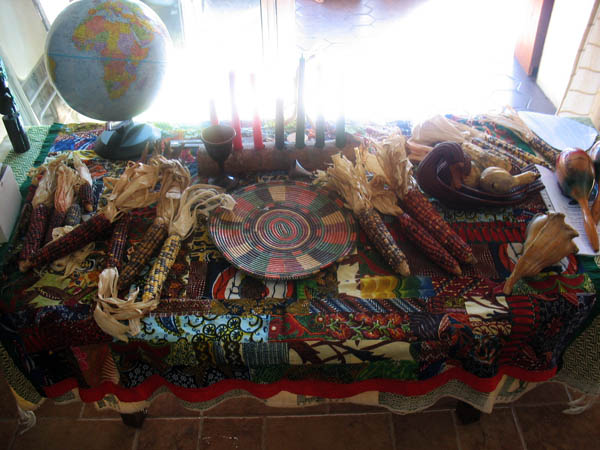
When I was elementary school age our neighborhood was majority Jewish. We never celebrated the Jewish holidays but we learned about them. I remember singing the dreidel song in school and learning about the menorah. I didn’t realize Kwanzaa was in the “another tradition” category until today, so here is my late offering. Once again I bring you a reprint from Ruff Draft 1991. We didn’t celebrate it when I was growing up since it didn’t begin until the late 1960’s. Our children grew up celebrating either at home or in community celebrations.
Kwanzaa
Kwanzaa is a Black holiday started in the U.S.A. in the 1960s.
This year on the last day of Kwanzaa, which was New Years Day, we had a big to-do and invited Henry over. We dressed up. Tulani and I in sarongs. That is material draped around your body and hung over your shoulder. James and Cabral wore baggy pants and African print shirts. Jilo and Ife, who were home on winter break, wore long skirts. All the girls but Jilo, wore geles (head wraps). Jilo didn’t want to cover her dreadlocks.
When Henry got there we were downstairs in our regular clothes so we ran upstairs and after much losing of skirts and falling off of wraps, we finally went down. As we went Tulani played the drum, James used the shakare, Cabral strummed the ukelele and I had to use two blocks. We chanted “Kwanzaa, First Fruits!” as we came. We giggled a little as we went through the kitchen. Black eye peas, sweet potatoes and rice were simmering on the stove for us to eat directly after the ritual. When we got to the living room, all the lights were off except one. By that light we, in turn, read the seven principles in Swahili and their meanings in English. The introduction was read by Daddy. Nia/Purpose was read by Henry. Umoja/Unity was read by Tulani. Kujichagulia/Self determination was read by Ayanna, Ujima/Collective Work and Responsibility by James. Ujamaa/Cooperative economics by Ife, Kuumba/Creativity by Mommy for Cabral and Imani/Faith by Jilo.
Then we read the meanings explained in plain English that Jilo had written. After we read the principles and lit all seven candles, Jilo read a story she had written about Kwanzaa with all of the principles included. We then ushered everybody into the dining room while chanting the principles and their meanings. Well, that was the plan, but nobody but us kids knew so the adults just sat there and watched us. So we finally just got up and told them to come to the table.
After dinner Henry told tales about when he was a kid and about his uncles and cousins. Some how the conversation went from reminiscing to the state of the world today. He and Jilo had quite a discussion that lasted for hours. At the end Henry went home and we all went to bed.